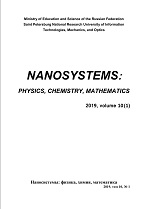|
This article is cited in 5 scientific papers (total in 5 papers)
CHEMISTRY AND MATERIAL SCIENCE
Very wide-bandgap nanostructured metal oxide materials for perovskite solar cells
L. L. Larinaa, O. V. Alexeevaa, O. V. Almjashevab, V. V. Gusarovc, S. S. Kozlova, A. B. Nikolskaiaa, M. F. Vildanovaa, O. I. Shevaleevskiya
a Department of Solar Photovoltaics, Institute of Biochemical Physics RAS,
Kosygin St. 4, Moscow, 119334, Russia
b St. Petersburg Electrotechnical University “LETI”, Professora Popova St. 5, Saint Petersburg, 197376, Russia
c Ioffe Physical-Technical Institute RAS, Politekhnicheskaya St. 26, Saint Petersburg, 194021, Russia
Abstract:
Very wide-bandgap undoped and Y$_2$O$_3$-doped ZrO$_2$ nanoparticles were synthetized and their structural, optical, morphological and energy characteristics were investigated. It was found that the bandgap value in ZrO$_2$ decreases with Y$_2$O$_3$ doping. The developed materials were used for fabrication of nanostructured photoelectrodes for perovskite solar cells (PSCs) with the architecture of glass/FTO/ZrO$_2$-Y$_2$O$_3$/CH$_3$NH$_3$PbI$_3$/spiro-MeOTAD/Au. The power conversion efficiency in the PSCs based on ZrO$_2$-Y$_2$O$_3$ photoelectrodes was significantly higher than that for undoped ZrO$_2$ photoelectrodes. We have found that nanostructured layers, based on very wide-bandgap materials could efficiently transfer the injected electrons via a hopping transport mechanism.
Keywords:
nanostructures, ZrO$_2$, thin films, semiconductors, solar photovoltaics, perovskite solar cells.
Received: 10.11.2018
Revised: 18.01.2019
Citation:
L. L. Larina, O. V. Alexeeva, O. V. Almjasheva, V. V. Gusarov, S. S. Kozlov, A. B. Nikolskaia, M. F. Vildanova, O. I. Shevaleevskiy, “Very wide-bandgap nanostructured metal oxide materials for perovskite solar cells”, Nanosystems: Physics, Chemistry, Mathematics, 10:1 (2019), 70–75
Linking options:
https://www.mathnet.ru/eng/nano417 https://www.mathnet.ru/eng/nano/v10/i1/p70
|

|




 Contact us:
Contact us: Terms of Use
Terms of Use
 Registration to the website
Registration to the website Logotypes
Logotypes








 Citation in format
Citation in format 
